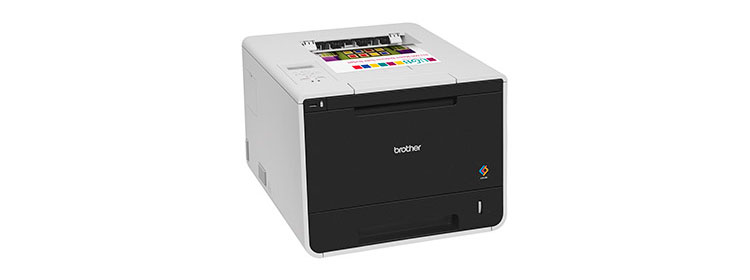While the Brother HL-L8250CDN ($349.99) matched the Editors’ Choice Xerox Phaser 6500/DN $252.98 at Amazon in our speed tests, and it offers better paper handling, its output quality can’t match the 6500/DN. But if you’re looking for a colorlaser printer for a micro or small office or workgroup, its speed and paper handling are enough to make it worth considering as your office workhorse.
Setup and Speed
The HL-L8250CDN is a little too big to share a desk with comfortably. It measures 12.3 by 16.1 by 19.1-inches (HWD), and it weighs enough, at 34.8 pounds, that you might need some help moving it into place.
Setup is typical for color lasers. I connected the printer to a wired network for my tests and installed the driver on a system running Windows Vista. One key difference between it and the Xerox 6500/DN is that the HL-L8250CDN installs to print in simplex (one-sided) mode rather than duplex by default. That gives it a faster speed than the Xerox printer on our official tests, but only because printing in duplex takes longer.
Brother rates the printer at 30 pages per minute (ppm), which is the speed you should see when printing a text document or other file that needs little to no processing. On our business applications suite, (using QualityLogic’shardware and software for timing) I clocked it at 6.6ppm, making it significantly faster than the Xerox 6500/DN’s official speed of 5.4ppm. However there’s a metaphorical asterisk that goes next to the Xerox printer’s speed.
In my unofficial tests with the Xerox printer in simplex mode, it came in at 6.5ppm, which means the two printers are actually tied for speed. (A 0.1ppm difference in our tests isn’t significant.) As another point of reference, both printers are a bit faster than the Samsung CLP-415NW$263.00 at Amazon, at 6ppm.
Output Quality
The HL-L8250CDN’s output quality overall is best described as good enough for most business use, but far short of impressive. Text quality is typical for a color laser, although it’s at the bottom of a very tight range where most color lasers fall. It’s not quite suitable for high-quality desktop publishing, but you shouldn’t have a problem with it for anything else, including printing with smaller fonts than most business documents use.
Graphics quality is a touch below what’s typical for a color laser, which still makes it easily good enough for any internal business use. Most people would consider it good enough for PowerPoint handouts and the like as well.
Photo quality is good enough to print recognizable photos from Web pages and such, but most photos in my tests had obvious quality issues, including banding, posterization (shading changing suddenly where it should change gradually), and visible dithering in the form of both graininess and dithering patterns.
Also worth nothing: If you connect the printer to a network, you can print through the cloud and from mobile devices over a Wi-Fi access point on your network.
If you need good quality for photos and graphics as well as for text, you’re better off with either the Editors’ Choice Samsung CLP-415 for light to moderate use, or the Editors’ Choice Xerox 6500/DN for more heavy-duty printing complete with duplexing. That said, if what you need is a medium- to heavy-duty workhorse color laser, but graphics and photo quality aren’t crucial, the Brother HL-L8250CDN’s speed and capable paper handling make it worth considering.







